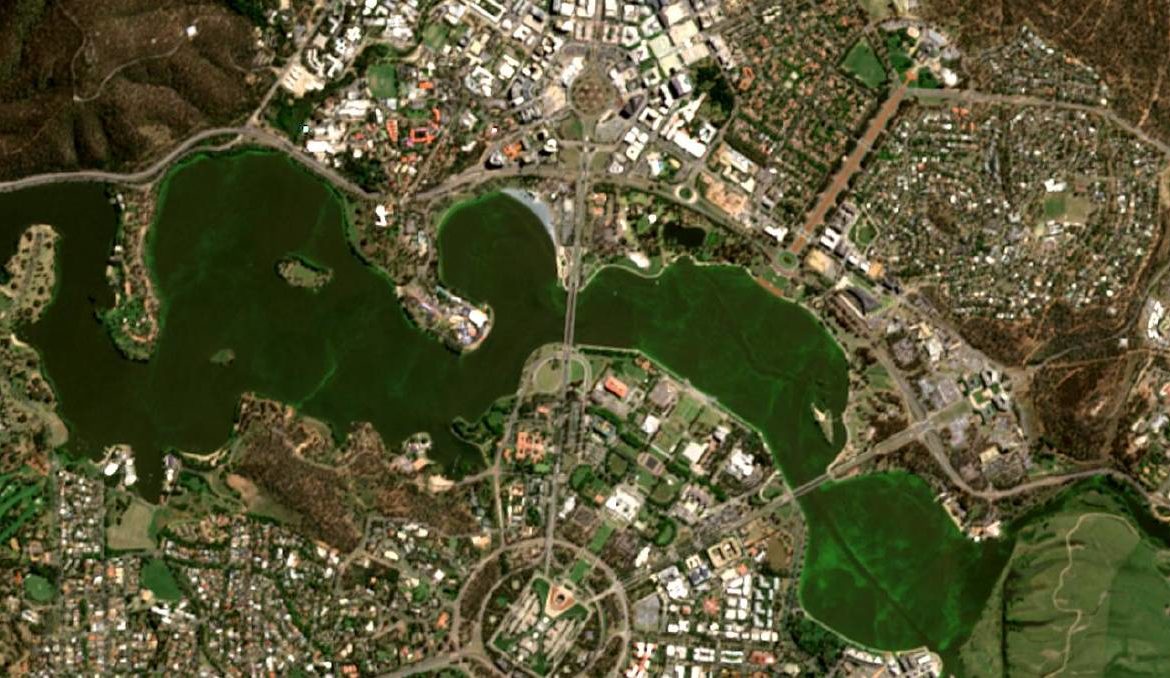news, environment, algae, algal blooms, lake burley griffin
Just how bad are the algal blooms that have surfaced across Lake Burley Griffin? So bad that you can see them from space. New images from the European Space Agency’s Copernicus Sentinel-2 satellite have picked up masses of blue-green algae blooms on Canberra’s lakes during a recent pass across south-eastern Australia. The satellite was launched in 2015, aimed at monitoring variability in land surface conditions. The satellite imagery picked up large swathes of green masses across all three basins of Canberra’s most famous lake. Areas of Lake Burley Griffin have been closed off to swimmers due to the algae blooms. The latest update issued by the National Capital Authority on March 4 closed off swimming in the lake at Black Mountain Beach, Yarralumla Beach, Acton Beach and Acton West Jetty. The algae has also forced the closure of the Captain Cook Memorial Jet until further notice. While swimming has been barred from the lake, secondary contact recreation, such as sailing and rowing, is still allowed. “Persons engaged in secondary contact recreation should be careful to limit any water exposure and should shower after contact with the water,” the National Capital Authority’s swim guide website said. READ MORE: “There is an increased risk of adverse health events from water exposure. Symptoms of exposure may include skin/mucosa irritation, flu-like symptoms, and gastrointestinal illness.” Pet owners have been warned not to let their animals swim or drink in the water, due to the algae being known to make pets very sick or even result in their death. Algae blooms have also forced the closure of the nearby Lake Tuggeranong in recent days, with the ACT government issuing an extreme alert level. Lake Tuggeranong was closed to primary contact such as swimming or water skiing but secondary contact recreation is still permitted. Lake Burley Griffin has been closed off several times in recent months due to the algae blooms. An extreme alert level was issued for the lake in January. Our journalists work hard to provide local, up-to-date news to the community. This is how you can continue to access our trusted content:
/images/transform/v1/crop/frm/Yb2Jn5LgcGxmVnDUUjd5xi/5d32d269-d63c-4a07-a710-62b9b775e41f.jpg/r0_99_1315_842_w1200_h678_fmax.jpg
Just how bad are the algal blooms that have surfaced across Lake Burley Griffin? So bad that you can see them from space.
New images from the European Space Agency’s Copernicus Sentinel-2 satellite have picked up masses of blue-green algae blooms on Canberra’s lakes during a recent pass across south-eastern Australia.
The satellite was launched in 2015, aimed at monitoring variability in land surface conditions.
The satellite imagery picked up large swathes of green masses across all three basins of Canberra’s most famous lake.
Areas of Lake Burley Griffin have been closed off to swimmers due to the algae blooms.
The latest update issued by the National Capital Authority on March 4 closed off swimming in the lake at Black Mountain Beach, Yarralumla Beach, Acton Beach and Acton West Jetty.
The algae has also forced the closure of the Captain Cook Memorial Jet until further notice.
While swimming has been barred from the lake, secondary contact recreation, such as sailing and rowing, is still allowed.
“Persons engaged in secondary contact recreation should be careful to limit any water exposure and should shower after contact with the water,” the National Capital Authority’s swim guide website said.
“There is an increased risk of adverse health events from water exposure. Symptoms of exposure may include skin/mucosa irritation, flu-like symptoms, and gastrointestinal illness.”
Pet owners have been warned not to let their animals swim or drink in the water, due to the algae being known to make pets very sick or even result in their death.
Algae blooms have also forced the closure of the nearby Lake Tuggeranong in recent days, with the ACT government issuing an extreme alert level.
Lake Tuggeranong was closed to primary contact such as swimming or water skiing but secondary contact recreation is still permitted.
An extreme alert level was issued for the lake in January.
Our journalists work hard to provide local, up-to-date news to the community. This is how you can continue to access our trusted content:







